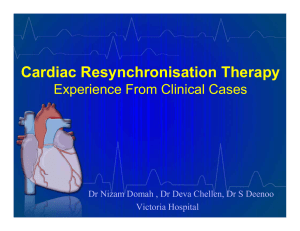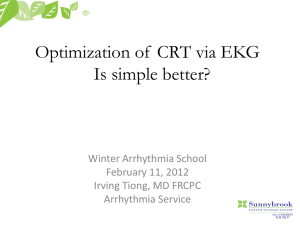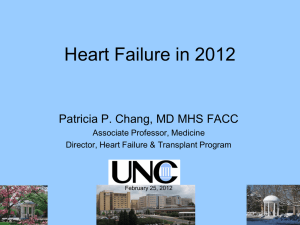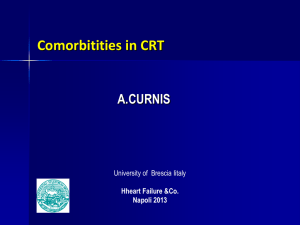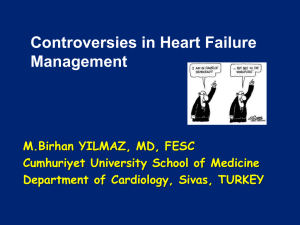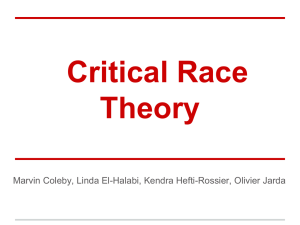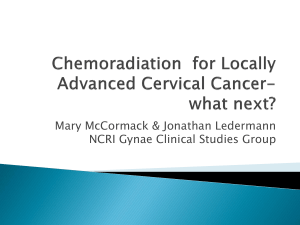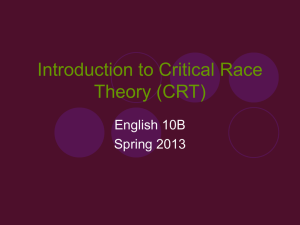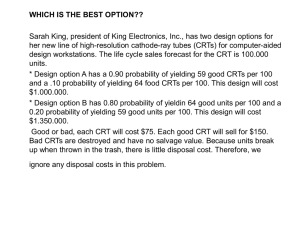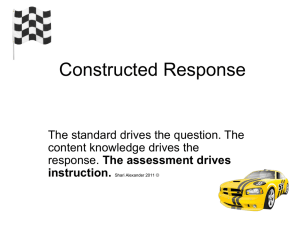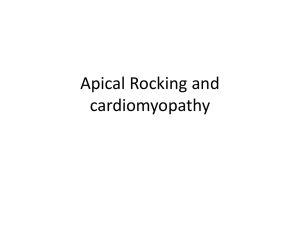CRT can be useful for pts who have LVEF ≤ 35%, SR, a non
advertisement
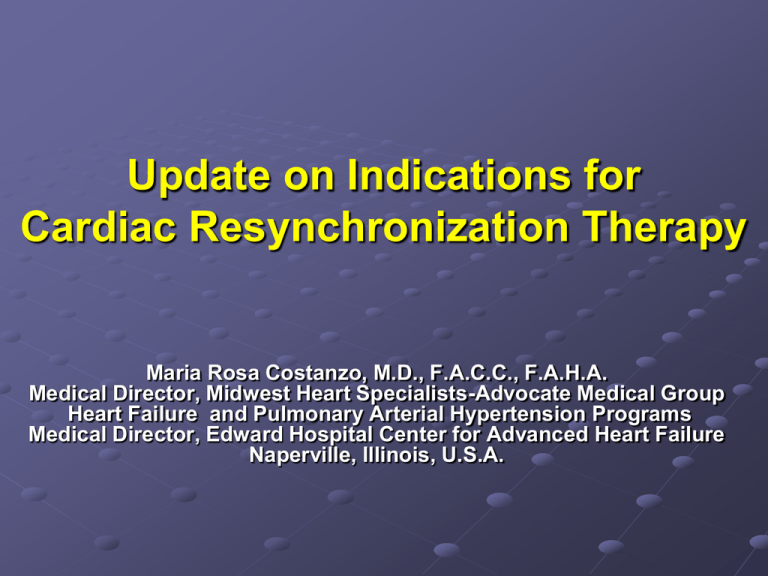
Update on Indications for Cardiac Resynchronization Therapy Maria Rosa Costanzo, M.D., F.A.C.C., F.A.H.A. Medical Director, Midwest Heart Specialists-Advocate Medical Group Heart Failure and Pulmonary Arterial Hypertension Programs Medical Director, Edward Hospital Center for Advanced Heart Failure Naperville, Illinois, U.S.A. ACC/AHA DBT guidelines, 2012 2012 ACCF/AHA/HRS Focused Update of the 2008 Guidelines for Device-Based Therapy of Cardiac Rhythm Abnormalities Class I CRT is indicated for pts. who have LVEF ≤ 35%, SR, LBBB with a QRS duration ≥ 150 ms, and NYHA class II, III, or ambulatory IV symptoms on GDMT. Level of Evidence: A for NYHA class III/IV (MIRACLE, COMPANION, CARE-HF); Level of Evidence: B for NYHA class II (MADITCRT) Comments Modified recommendation specifying CRT in pts with LBBB of ≥150 ms expanded to include those with NYHA class II symptoms Tracy CM et al. JACC 2012:60:1297-1311 2012 ACCF/AHA/HRS Focused Update of the 2008 Guidelines for Device-Based Therapy of Cardiac Rhythm Abnormalities Class IIa CRT can be useful for pts. with LVEF ≤ 35%, Sr, LBBB with a QRS duration 120 to 149 ms, and NYHA class II, III, or ambulatory IV symptoms on GDMT. (Level of Evidence: B) CRT can be useful for pts who have LVEF ≤ 35%, SR, a non-LBBB pattern with a QRS duration ≥ 150 ms, and NYHA class III/ambulatory class IV symptoms on GDMT. (Level of Evidence: A) CRT can be useful in pts. with AF and LVEF ≤ 35% on GDMT (Level of Evidence: B) if Comments New recommendation New recommendation a) the patient requires ventricular pacing or otherwise meets CRT criteria and b) AV nodal ablation or pharmacologic rate control will allow near 100% ventricular pacing with CRT. CRT can be useful for pts. on GDMT who have LVEF ≤ 35% and are undergoing new or replacement device placement with anticipated requirement for significant (>40%) ventricular pacing). (Level of Evidence: C) Modified recommendation (wording changed to indicate benefit based on EF rather than NYHA class; level of evidence changed from C to B). Modified recommendation (wording changed to indicate benefit based on EF and need for pacing rather than NYHA class); class changed from IIb to IIa). 2012 ACCF/AHA/HRS Focused Update of the 2008 Guidelines for Device-Based Therapy of Cardiac Rhythm Abnormalities Class IIb CRT may be considered for pts. who have LVEF ≤ 30%, ischemic HF etiology SR, LBBB with a QRS duration ≥ 150 ms, and NYHA class I symptoms on GDMT. (Level of Evidence: C) CRT may be considered for pts. who have LVEF ≤ 35%, SR, a non-LBBB pattern with QRS duration 120 to 149 ms, and NYHA class III/ambulatory class IV on GDMT). (Level of Evidence: B) CRT may be considered for pts. who have LVEF ≤ 35%, SR, a non-LBBB pattern with a QRS duration ≥ 150 ms, and NYHA class II symptoms on GDMT. (Level of Evidence: B) Comments New recommendation New recommendation New recommendations Tracy CM et al. JACC 2012:60:1297-1311 2012 ACCF/AHA/HRS Focused Update of the 2008 Guidelines for Device-Based Therapy of Cardiac Rhythm Abnormalities Class III CRT is not recommended for pts. with NYHA class I or II symptoms and nonLBBB pattern with QRS duration < 150 ms. (Level of Evidence: B) CRT is not indicated for pts whose comorbidities and/or frailty limit survival with good functional capacity to less than 1 year ). (Level of Evidence: C) Comments New recommendation Modified recommendation (wording changed to include cardiac as well as noncardiac comorbidities). Tracy CM et al. JACC 2012:60:1297-1311 The Influence of Left Ventricular Ejection Fraction on the Effectiveness of Cardiac Resynchronization Therapy: MADIT-CRT Kutyifa V et al. JACC. 2013;61:936-944 The Influence of Left Ventricular Ejection Fraction on the Effectiveness of Cardiac Resynchronization Therapy: MADIT-CRT Kutyifa V et al. JACC. 2013;61:936-944 The Influence of Left Ventricular Ejection Fraction on the Effectiveness of Cardiac Resynchronization Therapy: MADIT-CRT Kutyifa V et al. JACC. 2013;61:936-944 Device Therapy in Heart Failure: Has CRT Changed “the Sickest Benefit the Most” to “the Healthiest Benefit the Most?” JACC 2013;61(9):945-947 Differential Response to CRT by QRS Morphology and Duration Dupont M et al. JACC 2012; 60: 592-8 Histogram of QRS Duration in the Study Population Dupont M et al. JACC 2012; 60: 592-8 Echocardiographic and Clinical Response to CRT by QRS Morphology and Duration After CRT, patients with LBBB morphology and/or QRS duration ≥ 150 ms had statistically significantly greater improvement in: EF LVEDD LVESD MR grade change % of super-responders NYHA functional class Dupont M et al. JACC 2012; 60: 592-8 Survival after CRT Implantation Dupont M et al. JACC 2012; 60: 592-8 Cox Proportional Hazards Models for Death, Heart transplantation and LAVD Placement Variable Adjusted HR P Value LBBB and QRS ≥ 150 ms 1.00 LBBB and QRS <150 ms 1.52 (0.95-2.38) 0.08 Non-LBBB and QRS ≥ 150 ms 1.01 (0.65-1.55) 0.96 Non-LBBB and QRS <150 ms 1.42 (0.93-2.15) 0.10 Male 2.17 (1.14-3.44) 0.84 (0.60-1.17) 0.0003 0.30 1.55 (1.09-2.24) 0.98 (0.98-0,99) 0.97 (0.95-0.99) 0.01 < 0.0001 0.01 Age > 70 Ischemic CM eGFR Baseline EF Dupont M et al. JACC 2012; 60: 592-8 Changes in Echocardiographic Parameters in SuperResponder, Responder and Hyporesponder Groups Hsu JC et al. J Am Coll Cardiol. 2012; 59(25):2366-2373 Multivariable Analysis of Predictors of LVEF Super-Response Variable Odd Ratio 95% CI P value Female 1.96 1.32-2.90 0.001 QRS ≥ 150 ms 1.79 1.17-2.73 0.007 LBBB 2.05 1.24-3.40 0.006 BMI < 30 Kg/m2 1.51 1.03-2.20 0.035 No Prior MI 1,80 1.20-2.71 0.005 LAVI 1.47 1.21-1.79 < 0.001 Hsu JC et al. J Am Coll Cardiol. 2012; 59(25):2366-2373 Kaplan-Meier Estimates of Cumulative Probability of Heart Failure or Death, Death Alone, and Death or ICD Therapy for VT or VF Stratified by Response Category Hsu JC et al. J Am Coll Cardiol. 2012; 59(25):2366-2373 Cox Proportional Regression Analysis of Predictors of Nonfatal HF Events or Death Variable Hazard Ratio 95% CI P value LVEF response Super-responder Reference Hypo-responder 5.25 2.01-13.74 0.001 Responder 2.24 0.86-5.83 0.099 LBBB 0.57 0.34-0.94 0.029 Creatinine ≥ 1.4 mg/dL 3.02 1.66-5.49 < 0.001 Hsu JC et al. J Am Coll Cardiol. 2012; 59(25):2366-2373 ACC/AHA DBT guidelines, 2012 Conclusions Since the publications of the Miracle trial the indications for CRT have evolved Measures of mechanical dyssinchrony have been largely disappointing in predicting response to CRT QRS duration has endured as the single stronger predictor of CRT response The MADIT-CRT trial has extended the indications for CRT to patients with prolonged QRS and mild HF symptoms The ability to predict non-responders to CRT remains elusive The ADVANCED-CRT Registry will help to characterize nonresponders to CRT and to refine selection criteria for CRT
